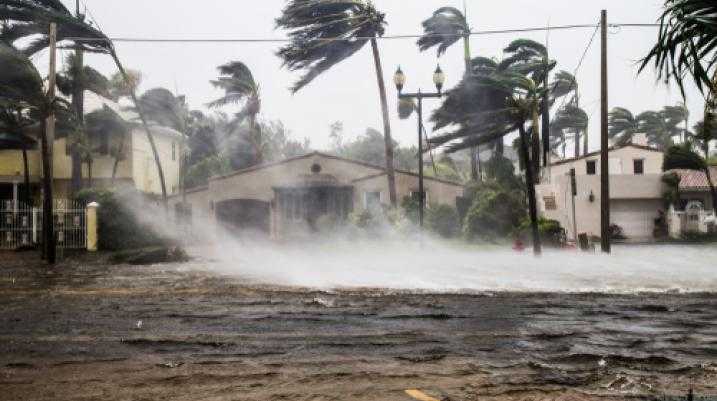Tropical Storm Emily Hits Florida, Ushering in Peak Hurricane Season

Well, it’s here: Peak hurricane season in Florida. Tropical Storm Emily’s sudden emergence on Anna Maria Island, near Bradenton, serves as a reminder to be prepared for what’s in store the next couple months. Given the odd nature of how Emily formed, observers are cautious, according to the Orlando Sentinel.
Emily made landfall on the morning of July 31 and took out power for 18,000 businesses and homes in Tampa Bay, Sarasota, and Naples. Even as evening came to pass, 5,300 customers in Manatee and Hillsborough counties were still stuck without power, the Sentinel said.
This particular tropical storm was atypical of what we expect... - Jessie Smith
The sudden emergence of Emily led Gov. Rick Scott to declare a state of emergency for 31 counties, including Orange, Seminole, Lake, Volusia, and Brevard, according to the Sentinel. There’s also the matter of where Emily showed up.
“This particular tropical storm was atypical of what we expect... Usually they develop well off in the Atlantic from a wave off the coast of Africa. [Emily] really developed almost instantly,” National Weather Service meteorologist Jessie Smith told the newspaper.
Attention home and business owners: have you suffered property damage after the last hurricane? Has your insurance company lowballed or denied your claim? If so, our hurricane insurance lawyers may be able to help. Visit HurricaneLawyers.com to learn more today.
More Hurricanes and Tropical Storms Are Probably Coming
As people in hurricane regions know too well, the peak of hurricane season is August through October, with September serving as the most active time of the season. In fact, some of the deadliest hurricanes in the past 100 years in the U.S. hit during that time.
Observers at the National Oceanic and Atmospheric Administration predicted back in May a 70 percent likelihood of there being anywhere from 11 to 17 named storms with winds of 39 mph or higher.
Most recently, Hurricane Matthew struck on Sept. 28 of last year and lasted in various forms until mid-October, killing hundreds of people and causing $15 billion in damage, including to parts of Florida and Georgia. There was also Hurricane Hermine, which occurred earlier in September and caused damage in parts of Florida as well.
Thankfully, Emily didn’t make it beyond tropical storm status before weakening to a tropical depression the very same day it came into our lives. That said, she was only the beginning.
Observers at the National Oceanic and Atmospheric Administration predicted back in May a 70 percent likelihood of there being anywhere from 11 to 17 named storms with winds of 39 mph or higher — five to nine of which would become full-blown hurricanes, with two to four becoming Category 3 or higher, according to the Sentinel report. (An average season has 12 named storms, officials say.)
Hurricane and Tropical Storm Damage Insurance Disputes: Stay Protected
Whatever the storm status, there’s the potential for your home and other private property to sustain damage. This leaves homeowners going through an insurance claims process that, at best, is a headache and, at worst, can be its own type of disaster.
Insurance companies sometimes use all sorts of hurricane damage and tropical storm damage dispute tactics to get out of having to pay out on your homeowners’ insurance policy, even though you’re a dutiful premium payer and even though your home sustained damage. They’ll do everything from deny you even have a policy, to finding ways to only partially cover your damage, to low-balling you on a payout, or taking too long to pay out a claim, among other things.
While there’s no surefire way to be protected against such tactics 100 percent of the time, there are ways stay empowered in the face of these unnecessary disputes.
By doing things like documenting the state of your property before and after a storm to making sure to mitigate against storm damage, and everything in between, you can help bolster your insurance claim. For more information, click on our storm safety checklist below.
Our Attorneys Will Go into the Eye of the Insurance Storm for You
Even the most prepared homeowners could find themselves in an insurance dispute with their insurer in the aftermath of hurricane damage and tropical storm damage. It’s about the last thing anyone wants to deal with when they’re already worrying about how to get their lives back on track after a storm.
This is where our insurance dispute attorneys at Morgan & Morgan come in. Our attorneys are from hurricane-prone areas and have spent decades in those areas helping homeowners take on powerful insurers who don’t seem to want to do what they’re supposed to do. If you’re stuck fighting an insurance company, contact us for a free, no-risk case evaluation. We'll do the fighting for you. Remember: As always, you don’t pay a penny until we win for you.
Injured? Getting the compensation you deserve starts here.
